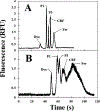3D printed microfluidic devices for integrated solid-phase extraction and microchip electrophoresis of preterm birth biomarkers
- PMID: 38401930
- PMCID: PMC10895869
- DOI: 10.1016/j.aca.2024.342338
3D printed microfluidic devices for integrated solid-phase extraction and microchip electrophoresis of preterm birth biomarkers
Abstract
Background: Preterm birth (PTB) is a leading cause of neonatal mortality, such that the need for a rapid and accurate assessment for PTB risk is critical. Here, we developed a 3D printed microfluidic system that integrated solid-phase extraction (SPE) and microchip electrophoresis (μCE) of PTB biomarkers, enabling the combination of biomarker enrichment and labeling with μCE separation and fluorescence detection.
Results: Reversed-phase SPE monoliths were photopolymerized in 3D printed devices. Microvalves in the device directed sample between the SPE monolith and the injection cross-channel in the serpentine μCE channel. Successful on-chip preconcentration, labeling and μCE separation of four PTB-related polypeptides were demonstrated in these integrated microfluidic devices. We further show the ability of these devices to handle complex sample matrices through the successful analysis of labeled PTB biomarkers spiked into maternal blood serum. The detection limit was 7 nM for the PTB biomarker, corticotropin releasing factor, in 3D printed SPE-μCE integrated devices.
Significance: This work represents the first successful demonstration of integration of SPE and μCE separation of disease-linked biomarkers in 3D printed microfluidic devices. These studies open up promising possibilities for rapid bioanalysis of medically relevant analytes.
Keywords: 3D printing; Microchip electrophoresis; Microfluidics; Preterm birth biomarkers; Sample preparation; Solid-phase extraction.
Copyright © 2024 Elsevier B.V. All rights reserved.
Conflict of interest statement
Declaration of competing interest The authors declare the following financial interests/personal relationships which may be considered as potential competing interests: GPN and ATW own shares in Acrea3D, a company that is commercializing 3D printers. The other authors have no conflicts to declare.
Figures







Similar articles
-
Automated microfluidic devices integrating solid-phase extraction, fluorescent labeling, and microchip electrophoresis for preterm birth biomarker analysis.Anal Bioanal Chem. 2018 Jan;410(3):933-941. doi: 10.1007/s00216-017-0548-7. Epub 2017 Aug 10. Anal Bioanal Chem. 2018. PMID: 28799040 Free PMC article.
-
Integrated electrokinetically driven microfluidic devices with pH-mediated solid-phase extraction coupled to microchip electrophoresis for preterm birth biomarkers.Electrophoresis. 2017 Jul;38(13-14):1743-1754. doi: 10.1002/elps.201700054. Epub 2017 Apr 25. Electrophoresis. 2017. PMID: 28272749 Free PMC article.
-
3D Printed Microfluidic Devices for Solid-Phase Extraction and On-Chip Fluorescent Labeling of Preterm Birth Risk Biomarkers.Anal Chem. 2020 Sep 15;92(18):12322-12329. doi: 10.1021/acs.analchem.0c01970. Epub 2020 Sep 3. Anal Chem. 2020. PMID: 32829631 Free PMC article.
-
Recent advances in microfluidic sample preparation and separation techniques for molecular biomarker analysis: A critical review.Anal Chim Acta. 2017 Sep 15;986:1-11. doi: 10.1016/j.aca.2017.07.043. Epub 2017 Jul 24. Anal Chim Acta. 2017. PMID: 28870312 Free PMC article. Review.
-
Applications of microfluidics and microchip electrophoresis for potential clinical biomarker analysis.Anal Bioanal Chem. 2015 Sep;407(23):6911-22. doi: 10.1007/s00216-015-8622-5. Epub 2015 Apr 9. Anal Bioanal Chem. 2015. PMID: 25855148 Free PMC article. Review.
Cited by
-
Advancement of microchip electrophoresis coupled with capacitively coupled contactless conductivity detection-from design to application (2018-2024).Anal Sci. 2025 Jul;41(7):903-921. doi: 10.1007/s44211-025-00771-3. Epub 2025 Apr 25. Anal Sci. 2025. PMID: 40279040 Review.
-
3D Printed Microfluidic Devices for Integrated Immunoaffinity Extraction, Solid-Phase Extraction, and Fluorescent Labeling of Preterm Birth Biomarkers.Precis Chem. 2025 Mar 3;3(5):261-271. doi: 10.1021/prechem.4c00092. eCollection 2025 May 26. Precis Chem. 2025. PMID: 40443764 Free PMC article.
-
Improving Meropenem Quantification in a Compact SERS-Based Centrifugal Microfluidic Platform: Toward TDM of Antibiotics in ICU.Anal Chem. 2025 Apr 15;97(14):7888-7896. doi: 10.1021/acs.analchem.4c06902. Epub 2025 Mar 25. Anal Chem. 2025. PMID: 40132957 Free PMC article.
References
-
- Soares da Silva Burato J; Vargas Medina DA; de Toffoli AL; Vasconcelos Soares Maciel E; Mauro Lanças F Recent advances and trends in miniaturized sample preparation techniques. J. Sep. Sci 2020, 43 (1), 202–225. - PubMed
-
- Chen Y; Xia L; Liang R; Lu Z; Li L; Huo B; Li G; Hu Y Advanced materials for sample preparation in recent decade. TrAC-Trends Anal. Chem 2019, 120, 115652.
-
- Xia L; Li G Recent progress of microfluidic sample preparation techniques. J. Sep. Sci 2023, 46 (15), 2300327. - PubMed
MeSH terms
Substances
Grants and funding
LinkOut - more resources
Full Text Sources

